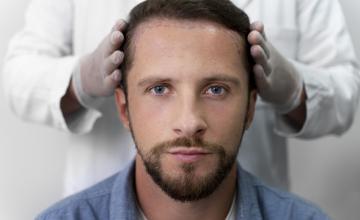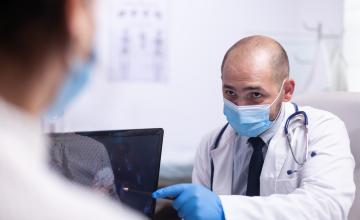Today's evolutionary high point - Ultra Refined Follicular Unit Transplantation
By relocating these carefully prepared bald-resistant follicular units, physicians doing "follicular unit hair transplantation" recreate a natural pattern of hair in the balding areas.
To do this properly is a very time consuming and exacting process. It requires a team of meticulous medical technicians working hand-in-hand with the hair transplant surgeon in a very lengthy surgical procedure.
Ultra Refined Grafting - Smaller Blades, Smaller Incisions, Smaller Grafts
Today's micro surgical blades, like the size of hair grafts, have become ever smaller and now enable hair transplant surgeons to safely make more tiny graft incisions in a given area then ever before. Surgeons are then able to "dense pack" select areas with as many as 40 to 60 follicular unit grafts per square centimeter. This graft density is as much as twice that of the standard follicular unit hair transplant procedure.
Such high densities of transplanted hair typically produce the appearance of fullness even after only one surgical session. Patients also experience rapid healing and no visible skin distortions due to the tiny size of these incisions.
Ultra Refined Follicular Unit Grafting - Hard on the clinic but easy on the patient.
Ultra refined follicular unit grafting raises the bar for physicians and their staff. This delicate and demanding hair transplant procedure requires more skill and careful attention to be performed properly. The smaller and more tightly packed incisions require more closely dissected follicular unit grafts that are carefully trimmed under microscopes. These small and densely packed incisions are also more difficult to place the grafts into.
This procedure also requires more careful patient selection, as "dense packing" of grafts is not appropriate for all patients.
Ultra Refined Follicular Unit Transplantation - the new "Gold Standard"
In the hands of a highly skilled physician and staff the Ultra refined follicular unit hair transplant procedure can achieve excellent new hair growth that is so natural that it is undetectable even under close scrutiny.
While the standard micro "follicular unit" hair transplant does produce natural looking results, its ability to achieve high density in only one surgical session is limited. Thus patients may have to do subsequent surgical sessions in a transplanted area to achieve a full look.
The many patient benefits of this new ultra refined procedure are significant and include:
- The ability to get excellent hair density in only one surgical session.
- Minimal trauma in the graft recipient area with rapid post surgical healing.
- Little or no visible pitting or distortions in the transplanted areas.
- More natural direction and angulation of the transplanted hair.
All physician members of the Coalition perform Ultra Refined Follicular Unit Hair Transplantation.
While many hair transplant physicians perform quality follicular unit hair transplants, only some of them are capable of performing large sessions of ultra refined follicular hair transplantation. However, all members of the Coalition of Independent Hair Restoration Physicians perform ultra refined grafting with excellent results.
The Future of Surgical Hair Restoration
The amount of hair you can transplant is ultimately limited by the amount of hair follicles you can safely relocate from the bald resistant donor area at the back and sides of your head.
Some day it may be possible for physicians to create multiple hair follicles from one original follicle. This process typically called Hair Multiplication or more incorrectly Hair Cloning is currently being investigated by several research scientists and hair restoration physicians.
If and when this process is successfully developed patients would no longer be limited by the finite amount of bald resistant hairs that can be relocated from their donor area. Hair multiplication would result in a virtually limitless supply of hair available for hair transplants.
This would be especially good news for men or women with extensive baldness and a very limited supply of donor hair. Even those with extensive baldness would theoretically be able achieve thick full heads of hair.
However, experts believe that we are at least ten years away from hair multiplication being available, if even then. But perhaps some day scientists will be able to use gene therapy to halt the balding process without drugs or surgery.






